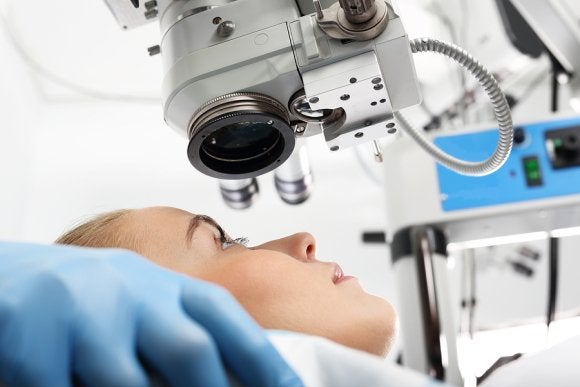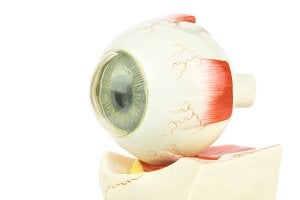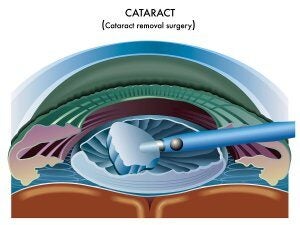-
The Cataract Surgery Process
Cataract surgery is a safe and straightforward process that will improve your vision and help you lead a normal lifestyle. Cataracts cause the eye lenses to become cloudy, preventing light from reaching the eye, and hindering normal vision. Cataracts usually occur in older adults, and they are especially common in those with diabetes. Fortunately, your ophthalmologist in Chicago can reverse this condition and improve your vision with cataract surgery.
The cataract surgery process begins with an evaluation by your eye doctor. He or she will perform several tests to see how severe your cataracts are. Then, the optician will explain the cataract treatment process to you, along with its risks.
With your consent, the eye doctor will begin the surgery by giving you a local anesthetic. He or she will break up your clouded lens using sensitive ultrasound vibrations and remove it using suction. Finally, the doctor will replace the old lens with a new, artificial one. Upon your request, this new lens can be modified to give you better vision than you’ve ever had before.

-
Get Your Sight Back with Cataract Surgery [INFOGRAPHIC]
Cataracts are a relatively common condition, and become even more common with age. Almost 25% of people between the ages of 64 and 69 have cataracts, and the percentage rises with age. Cataracts occur when the lens inside the eye becomes clouded, affecting your ability to see. As cataracts get worse, your vision will grow increasingly impaired. Instead of living with vision loss, consider cataract treatment near Chicago so you can see as well as—if not better than—you did before. Advances in intraocular lens technology allow your eye surgeon to implant lenses that correct cataracts as well as vision issues such as nearsightedness and astigmatism. Take a look at this infographic to learn more about cataract surgery and how it can benefit you. Please share with your friends and family!

-
What Is a Cortical Cataract?
 A cataract is an eye condition that causes worsening vision and eye problems if it is not treated by an eye doctor. The symptoms of cataracts include blurry vision, sensitivity to light, poor night vision, double vision, seeing halos around light sources, distortion of color perception, and frequent changes in contact lens or eyeglasses prescriptions. Cataracts can be diagnosed and treated by an eye doctor or ophthalmologist near Chicago .
A cataract is an eye condition that causes worsening vision and eye problems if it is not treated by an eye doctor. The symptoms of cataracts include blurry vision, sensitivity to light, poor night vision, double vision, seeing halos around light sources, distortion of color perception, and frequent changes in contact lens or eyeglasses prescriptions. Cataracts can be diagnosed and treated by an eye doctor or ophthalmologist near Chicago .There are three primary types of cataracts: subcapsular cataracts, nuclear cataracts, and cortical cataracts. Cortical cataracts cause a worsening of vision that begins in the peripheral vision. You may notice cloudy, white floaters that progress from the periphery of your vision towards the center. Cortical cataracts occur in the lens cortex, or the part of the eye’s lens that surrounds the central nucleus.
If you suffer from cataracts, an eye doctor or ophthalmologist may first try to correct your vision using eyeglasses or contact lenses. If this treatment doesn’t work and the cataracts progress, you may need to undergo cataract surgery. Often, cataract surgery is the only truly successful method of cataract treatment.
-
Understanding Cataracts
A cataract is a cloudy area in the lens of the eye that makes it difficult to see. Cataracts can be caused by aging, sunlight exposure, and eye injuries. They can be diagnosed and treated by an eye doctor or ophthalmologist in Chicago . Treatment may include corrective lenses and/or surgery.
Watch this video to learn more about cataracts. An eye doctor with the National Eye Institute discusses the causes, symptoms, diagnosis, and treatment options for those with cataracts. Cataracts can cause a slow, gradual loss of vision, and some people are not afflicted with vision loss at all. If you suspect you may be suffering from cataracts, visit an eye doctor or ophthalmologist near you.
-
When to Have Cataract Surgery
 The only effective treatment for cataracts is to undergo cataract surgery . However, not everyone needs cataract surgery right away. If you’ve been diagnosed with this eye condition, you can consult a cataract surgeon serving Chicago for personalized recommendations. The cataract surgeon may inform you that you do not necessarily need surgery right away if the cataract is not interfering with your daily activities or causing blurry vision. Some individuals only undergo surgery when their cataracts cause problems with reading, driving, or other activities.
The only effective treatment for cataracts is to undergo cataract surgery . However, not everyone needs cataract surgery right away. If you’ve been diagnosed with this eye condition, you can consult a cataract surgeon serving Chicago for personalized recommendations. The cataract surgeon may inform you that you do not necessarily need surgery right away if the cataract is not interfering with your daily activities or causing blurry vision. Some individuals only undergo surgery when their cataracts cause problems with reading, driving, or other activities.However, if you do have the option of waiting to have surgery, you should be aware of the potential risks associated with letting a cataract go untreated. For example, some cataracts that are left untreated for long periods of time can cause inflammation or increased eye pressure, which can contribute to glaucoma. Previously, cataract surgeons could only perform surgery when the cataract was already in an advanced stage of development. As a cataract develops, it becomes harder. Thanks to modern eye surgery technology, ophthalmologists can now remove cataracts when they are at any stage of development.
-
Detecting Glaucoma
An eye doctor in Chicago can look for indicators of glaucoma during a comprehensive dilated eye exam. First, the ophthalmologist will apply special eye drops to each of your eyes. You’ll need to wait a few minutes for the drops to dilate your pupils, or enlarge them. When the pupils are dilated, the ophthalmologist can clearly see the optic nerve, macula, and retina. He or she will look for changes that can indicate glaucoma , such as changes in the shape or color of the optic nerve, or cupping of the optic disc.
To hear more about making a dilated eye exam part of your eye care routine, watch this video. You’ll see an animation that demonstrates how this exam is performed and what changes can occur when a patient has glaucoma. This video also discusses some of the risk factors associated with glaucoma and offers recommendations regarding how often patients should have a dilated eye exam.
-
The Causes and Symptoms of Cataracts
 Many people underestimate the importance of having regular examinations at an optical center in Chicago. This is unfortunate because an ophthalmologist can do much more than provide an accurate prescription for corrective lenses. An ophthalmologist can also look for the early warning signs of vision problems such as cataracts, which refer to cloudiness on the lens of the eye. Cataracts are among the most common causes of vision impairment. If you’ve already been diagnosed with cataracts, you can talk to an ophthalmologist about cataract treatment .
Many people underestimate the importance of having regular examinations at an optical center in Chicago. This is unfortunate because an ophthalmologist can do much more than provide an accurate prescription for corrective lenses. An ophthalmologist can also look for the early warning signs of vision problems such as cataracts, which refer to cloudiness on the lens of the eye. Cataracts are among the most common causes of vision impairment. If you’ve already been diagnosed with cataracts, you can talk to an ophthalmologist about cataract treatment .Symptoms
You may not necessarily notice symptoms of cataracts until they have progressed. Cataracts develop slowly over time. As they develop, you might begin to notice symptoms such as foggy, filmy, blurry, or cloudy vision. Double vision, progressive nearsightedness, and difficulty coping with glare during the day are other indicators of cataracts. You may also have difficulty with glare at night, such as glare from the headlights of oncoming vehicles. You might suddenly need a stronger prescription for your corrective lenses and you may notice that you begin to perceive colors differently.
Causes
Cataracts develop when the lens of the eye develops an accumulation of proteins. These proteins cause the cloudiness that prevents the lens from properly focusing light on the retina, which is the back of the eye. This causes vision impairment. There are different underlying causes that may contribute to the accumulation of proteins. Ophthalmologists classify different types of cataracts according to their underlying causes.
Types
For example, a patient might be diagnosed with an age-related cataract, which occurs as a result of changes during the aging process. Cataracts are quite common among adults aged 65 and older. However, it is possible for babies to be diagnosed with congenital cataracts, which are present at birth. Congenital cataracts can develop as a result of poor fetal development, or an injury or infection that affected the fetus. Some people are diagnosed with traumatic cataracts. As the name implies, these develop after an eye injury. Secondary cataracts are caused by certain medical conditions. These can include diabetes, exposure to ultraviolet light, exposure to radiation, or exposure to toxic substances. Some medications can also cause secondary cataracts, including diuretics and corticosteroids.
-
How Are Cataracts Diagnosed?
 A cataract surgeon serving Chicago can conduct a comprehensive eye examination to diagnose cataracts . First, the cataract surgeon will review your medical history and ask you about your symptoms. You can expect to have a refraction and visual acuity test, during which you’ll be asked to cover one eye, then the other, while reading rows of letters of various sizes. The ophthalmologist will likely perform a slit-lamp exam, which enables him or her to assess your corneas, iris, and lens. The slit-lamp exam allows your ophthalmologist to look for very small abnormalities in these structures.
A cataract surgeon serving Chicago can conduct a comprehensive eye examination to diagnose cataracts . First, the cataract surgeon will review your medical history and ask you about your symptoms. You can expect to have a refraction and visual acuity test, during which you’ll be asked to cover one eye, then the other, while reading rows of letters of various sizes. The ophthalmologist will likely perform a slit-lamp exam, which enables him or her to assess your corneas, iris, and lens. The slit-lamp exam allows your ophthalmologist to look for very small abnormalities in these structures.Another test for the diagnosis of cataracts is a retinal examination. Your ophthalmologist will administer special eye drops to each eye. These eye drops will dilate your pupils, or make them larger, which allows the eye doctor to evaluate your retina. You’ll need to wait for a few minutes for the eye drops to work. Then, your ophthalmologist will use a slit-lamp or an ophthalmoscope to check for signs of a cataract.
-
Symptoms of Cataracts
Cataracts are a common reason why people visit an ophthalmologist near Chicago . Cataracts occur when the lens of the eye becomes cloudy. They develop very gradually. Although they lead to vision loss, this can occur over a period of years. As time passes, individuals may notice that they have problems driving, particularly at night. They may notice blurry or dim vision, sensitivity to glare, double vision, or seeing “halos” around sources of light. Because these symptoms can eventually interfere in day-to-day activities, it’s important to consult an eye doctor as soon as you begin to notice them.
Watch this video to hear a cataract surgeon discuss the signs and symptoms of cataracts. He explains the gradual onset of the symptoms and discusses the activities these symptoms may interfere with. If you suspect you could have cataracts, you can talk to an ophthalmologist about cataract surgery.
-
The Cataract Surgery Procedure
 Cataracts are cloudy areas on the lens of your eye that interfere with your ability to see clearly. If you’re anticipating having cataract surgery near Chicago, you can talk to your eye doctor about what you can expect from the procedure. Your cataract surgeon will determine if you’re a good candidate for the surgery, inform you of the potential risks, and explain the many benefits of cataract surgery.
Cataracts are cloudy areas on the lens of your eye that interfere with your ability to see clearly. If you’re anticipating having cataract surgery near Chicago, you can talk to your eye doctor about what you can expect from the procedure. Your cataract surgeon will determine if you’re a good candidate for the surgery, inform you of the potential risks, and explain the many benefits of cataract surgery.Preparation
Before having any type of surgery, you can expect to undergo some tests and discuss your medical history. For cataract surgery, your eye doctor will perform an A-scan to measure the length of your eye. Then, keratometry is used to measure the curve of the cornea. These measurements will inform your eye doctor’s recommendations for the type of intraocular lens (IOL) implant that best suits your needs. The lens implant can provide full vision correction . In addition to discussing the different types of IOL implants available to you, you’ll be asked about your medical history. Your eye doctor will need to know if you’ve previously had eye surgery, such as LASIK surgery. Additionally, you’ll need to disclose all of your medications, since certain drugs can interfere with pupil dilation.
Procedure
There are a few techniques that may be used for cataract surgery; however, phacoemulsification is most often used. First, your eye doctor will apply a local anesthetic to eliminate discomfort. Then, a very small incision is made in the cornea. The ophthalmologist inserts a tiny instrument that emits high-frequency ultrasound to essentially liquefy the lens so that it can be suctioned out. The next step in cataract surgery is to place an IOL implant. Finally, the incision is closed.
Recovery
It’s important to follow your eye doctor’s post-operative directions. After your surgical procedure you will rest for a little while in a recovery area. You will need someone to drive you home after your surgery. You may be up and about as you wish, but avoid strenuous activities. Also you will experience sensitivity to light that may require you to wear sunglasses on the day of your procedure. You’ll also need to apply eye drops as directed by your eye doctor.
